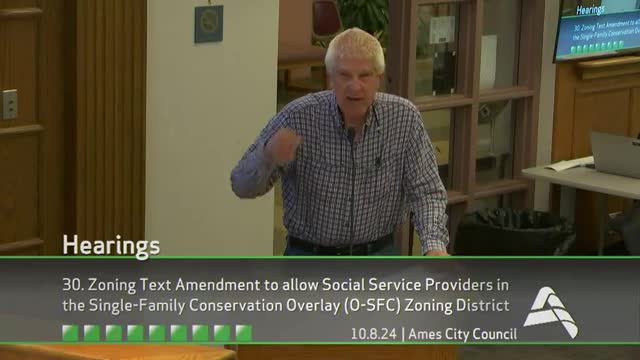Community Divided Over Proposed Zoning Changes
October 08, 2024 | Ames City, Story County, Iowa
This article was created by AI summarizing key points discussed. AI makes mistakes, so for full details and context, please refer to the video of the full meeting. Please report any errors so we can fix them. Report an error »

In a recent government meeting, significant concerns were raised regarding proposed zoning amendments that could impact the character of a historic neighborhood in Ames. The discussions centered around the potential for increased social service providers in the area, particularly in relation to the Romero House, which aims to provide services for the homeless.
Several council members and community members voiced their apprehensions about the implications of allowing more social services in a predominantly residential zone. One speaker emphasized the need for a comprehensive analysis of existing social service providers in the community, arguing that the council should gather more information before making any decisions. They highlighted the importance of understanding the current landscape of social services and their locations to avoid overwhelming the neighborhood.
Concerns were also raised about the zoning process itself, with some arguing that the proposed amendments should have been reviewed by the Historic Preservation Commission prior to consideration by the Planning and Zoning Commission. The potential for the amendments to affect a large percentage of properties in the historic district was a key point of contention, with calls for more public input and a thorough evaluation of the economic impacts on property values.
Community members expressed fears that the proposed changes could lead to a concentration of social services, which they believe could diminish the neighborhood's character and property values. One resident noted that studies suggest property values can decrease significantly near homeless service providers, raising alarms about the long-term implications for homeowners.
The meeting also highlighted a divide among residents regarding the balance between addressing homelessness and preserving the integrity of the neighborhood. While some advocated for the need to provide services for vulnerable populations, others stressed the importance of maintaining a family-friendly environment and the unique character of the historic district.
As the council deliberates on the proposed zoning amendments, the call for a pause in the decision-making process to allow for further research and community engagement remains strong. The outcome of this discussion could have lasting effects on the neighborhood's future and its approach to social services.
Several council members and community members voiced their apprehensions about the implications of allowing more social services in a predominantly residential zone. One speaker emphasized the need for a comprehensive analysis of existing social service providers in the community, arguing that the council should gather more information before making any decisions. They highlighted the importance of understanding the current landscape of social services and their locations to avoid overwhelming the neighborhood.
Concerns were also raised about the zoning process itself, with some arguing that the proposed amendments should have been reviewed by the Historic Preservation Commission prior to consideration by the Planning and Zoning Commission. The potential for the amendments to affect a large percentage of properties in the historic district was a key point of contention, with calls for more public input and a thorough evaluation of the economic impacts on property values.
Community members expressed fears that the proposed changes could lead to a concentration of social services, which they believe could diminish the neighborhood's character and property values. One resident noted that studies suggest property values can decrease significantly near homeless service providers, raising alarms about the long-term implications for homeowners.
The meeting also highlighted a divide among residents regarding the balance between addressing homelessness and preserving the integrity of the neighborhood. While some advocated for the need to provide services for vulnerable populations, others stressed the importance of maintaining a family-friendly environment and the unique character of the historic district.
As the council deliberates on the proposed zoning amendments, the call for a pause in the decision-making process to allow for further research and community engagement remains strong. The outcome of this discussion could have lasting effects on the neighborhood's future and its approach to social services.
View full meeting
This article is based on a recent meeting—watch the full video and explore the complete transcript for deeper insights into the discussion.
View full meeting
